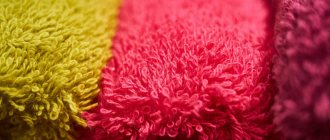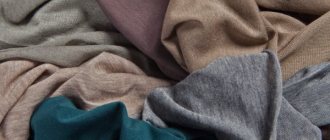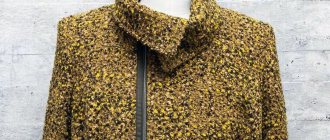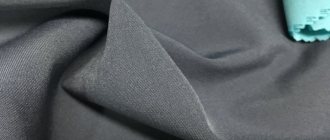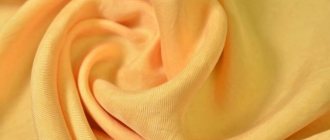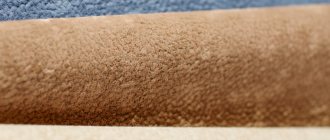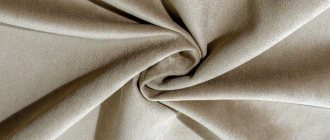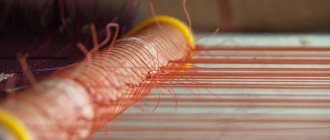One of the common materials in everyday life is terry cloth, or terry. Towels, bathrobes, napkins and other household and bath accessories are made from it. Its other name is frote (from French - “grated”). High-quality terry is hypoallergenic and consists mostly of natural fibers. It has a soft pile structure and high absorbency.
Advantages and disadvantages
The demand for terry fabric is explained by consumer characteristics:
- functionality, because moisture is absorbed, the massage and “breathing” properties of the fabric are manifested, and the circulation of tissue fluid improves in a person;
- ergonomics is associated with ease of use (does not wrinkle or deform) and the lack of special care, as well as hygienic indicators, the latter guaranteeing vapor and air permeability, heat protection and hygroscopicity, antibacterial and hypoallergenic;
- aesthetics have led to a range of applications, from children's clothing to household items, which can be painted in any color, which allows for the implementation of design solutions, and thanks to color fastness, the original appearance is preserved;
- wear resistance and durability, with shrinkage and stretching being minimal due to resistance to deformation;
- environmental safety, raw materials without harmful additives are used in production, so personal hygiene items made from terry are recommended for allergy sufferers.
Flaws:
- lack of elasticity;
- threads break due to mechanical damage and stretching;
- weight of products;
- long drying;
- accumulation of dust and dirt.
Service life of towels
Even with proper care, high quality towels will wear out over time and need to be replaced. There are different standards for each industry, but generally speaking, the lifespan of a towel is related to three main factors:
- Quality. Cheap towels do not last as long as high-quality towels.
- Frequency of use. The more and longer a towel is used, the shorter its lifespan.
- Level of care. If you take good care of your towel, washing, drying and caring for it properly, it will last longer than if you neglect it.
Typically, there are two clear signs that it's time to replace your towels:
- Your towel is worn out or has lost its absorbency and softness. After a year or two, the threads of your towel fabric begin to break down. When the fibers become unusable, it is time to purchase a new product.
- Your towel smells bad. Old towels or towels that have not been properly washed can give off a musty odor that persists even with regular washing. When this happens, it's time to replace it.
We'll tell you what to make from an old towel here.
Types of terry
Frote is classified according to the following indicators:
- Density from 300 to 800 g/m2, the most common terry is 350-500 g/m2, high-density products are expensive, with increased absorbent properties, but heavy.
- The length of the pile affects the hygroscopicity (higher for long piles);
- Pile location: depending on this factor, they are divided into single- and double-sided fabric.
- The presence of loops: they produce uncut and cut terry, on which designs are depicted by combining piles that differ in length and angle of inclination.
Towel linen fabric
Currently, the main production of flax occurs by machine: from combed flax a more delicate and soft fiber is obtained, from tow - coarser ones: canvas and burlap. The good advantage of this material is its high strength, excellent hygroscopicity, linen perfectly absorbs and releases moisture, making this fabric one of the most common in the production of towels. In addition, linen towel fabric can easily withstand temperatures up to 170 degrees, so towels made from this material can be used as a potholder in the kitchen when removing a dish from the oven.
It should be noted that it has good resistance to organic solvents and alkalis; the material does not accumulate electricity. The fabric contains silica, thanks to which this fabric prevents the development of bacteria, which is very important in the kitchen where food is prepared every day.
Care Tips
Regardless of the raw material composition, it is recommended:
- hand or machine wash at 60°C, 90°C is allowed for white cotton items, which can also be bleached;
- do not use the water saving mode due to high hygroscopicity; detergents may remain on the surface and cause allergies; for the same reason, prefer liquid detergents;
- do not wash together with items that have fittings on them, they may damage the hinges; an alternative is to use a protective bag;
- set to a spin speed not exceeding 800 rpm;
- periodically use a machine dryer;
- exclude ironing, which worsens absorbency, but steaming to raise the pile is sometimes possible;
- Carefully trim the loose loops with scissors to improve their appearance.
Service life of towels
When purchasing products for your home, you should learn about the proper care of your kitchen towel. If you take care of your towel, you will save money and use it for a long period of time. Proper care of your towel is critical for several important reasons:
- Towels are some of the most germ-prone items in your home. They retain moisture, which is an ideal breeding ground for dangerous bacteria.
- Towels are usually used in the dirtiest places. Kitchens and bathrooms tend to be the dirtiest areas of the home, and are also where towels are used the most.
- Dirty kitchen towels can contain thousands of bacteria. Towels used in the kitchen are especially susceptible to the growth of dangerous intestinal bacteria, which are found in feces and lead to outbreaks of diarrhea and food poisoning. In one study, E. coli bacteria were found in 89 percent of kitchen towels.
- Towels can transmit diseases from one person to another. If you don't change towels when needed or don't clean them properly between uses, they can spread disease. E. coli, fungus, coliform bacteria and salmonella can be transmitted from one person to another through dirty towels.
It's pretty obvious why it's important to care for your towels properly and replace them when necessary, but it's worth taking a closer look at how to best care for them.
Selection of terry products
Study the raw material composition: artificial fibers should be no more than 20%, if 100% cotton is specified, but washing above 60 ° C is not allowed, this may indicate “hidden” synthetics. The density indicator is higher for products with greater moisture absorption, so it is better to buy a terry robe for a bath, sauna, or swimming pool with a higher density. The pile should be uniform, except in cases where changes in length are associated with a geometric pattern, and fibers should not remain on the hands, especially important for kitchen towels. Choose trusted manufacturers, do not hesitate to ask the seller for compliance documents. Terry made from flax and bamboo is softer and fluffy, so the price cannot be reduced.
Terry fabric is a priority among all target groups due to its high quality indicators, which are easy to maintain with proper care. Use the information provided at the stages of selection and operation, then the durability of the product and good mood are guaranteed.
Fabric for kitchen towels
Tea towels are more a matter of appearance than function, although they should still serve their primary purposes, such as wiping hands and cleaning small countertops. If you need more absorption, then choose cotton instead of linen.
Cotton waffle towel
Waffle fabric for towels, made of cotton, is durable and has high absorbent qualities. Their fluffy, textured surface is pleasant to the touch and easily traps water into its fibers. This type of towel is ideal for wiping up countertops and spills of various kinds.
Twisted cotton or linen towel
Light, fine weaves of cotton or linen fibers will make dusting and cleaning glass and crystal easier. Look for towels with a smooth appearance made from cotton or linen yarn that won't fade or deteriorate after washing.
Microfiber
Microfiber is a very durable fabric that can absorb significant amounts of liquid. The cloth can be used either dry or dampened with tap water or a cleaning agent. However, microfiber kitchen towels may take longer to dry compared to a traditional cotton or linen towel.
Bamboo fiber
Bamboo is an environmentally friendly material with high absorbency, soft and elastic. In addition, it can give the product a luxurious, cozy look. Bamboo fiber does not fade and has antibacterial qualities, making it an ideal choice for the kitchen. In addition, such a towel can be used to dry your hands.
Egyptian cotton
This high-quality cotton has long fibers and high absorbency, making it a top choice for luxury homes. Egyptian cotton is soft and skin-friendly and has a more luxurious appearance. With proper care, Egyptian cotton tea towels can serve you faithfully for a relatively long time.
Organic cotton
Certified organic cotton is produced from crops that are grown without the use of synthetic fertilizers or pesticides. In this case, the crop is harvested using special sustainable methods. Organic cotton kitchen towels look and perform just like standard cotton, but leave a smaller carbon footprint.
Material requirements
Fabric for kitchen towels should be durable, soft, absorb liquid, and retain its original appearance after numerous washes. The parameters that the material must meet are presented in the table.
| Property | Description |
| Absorption | The purpose requires the absorption of liquids - water, oil, sauce. |
| Softness | Glass or varnished surfaces require careful care. A soft towel will not leave scratches or streaks. |
| Strength | Long-term operation and preservation of attractiveness are indicators that housewives pay attention to. |
| Easy cleansing | Caring procedures in automatic mode, boiling - a guarantee of maintaining the snow-whiteness of kitchen accessories. |
A material suitable for making kitchen towels should dry quickly and not require ironing.
Fabric for bath towel
The determining criterion for choosing fabric for a bath towel is its ability to absorb moisture. It is also important to choose a thicker towel. The following types of fabric are a good option: cotton, linen, velor, waffle towels, terry, bamboo, modal, tencel, as well as polyamide and others. From a wide range of materials, the choice should be made from the naturalness of the fabric. Synthetic fabrics may cause irritation to sensitive skin. Cotton, as well as linen and terry, are good for everyday use.
What fabric to choose for a towel?
When wondering which fabric is best for a towel, you must proceed from certain criteria. A good solution for sewing towels for the kitchen would be natural fabrics that have an antibacterial effect, are hypoallergenic and absorb moisture well. Various fabrics are used to produce bath towels; terry is the best option. This is a soft fabric that absorbs moisture well and quickly enough. Material safety will be another critical criterion. High-quality fabric will provide the pleasure of using a towel anywhere: in the kitchen, as well as at home and in the bathroom.
